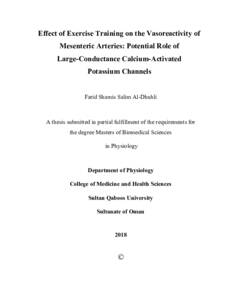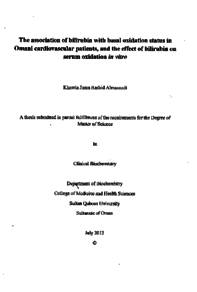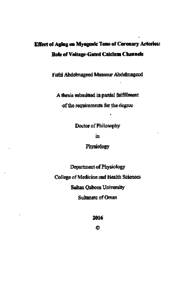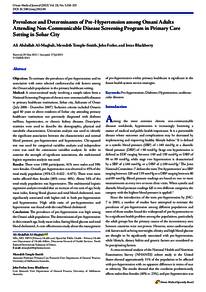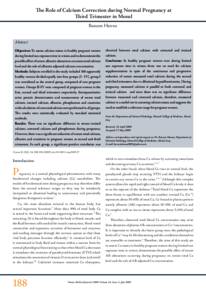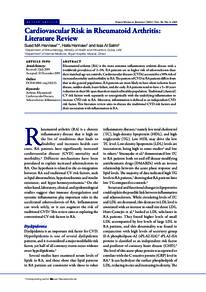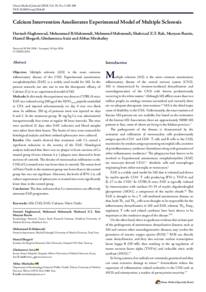Document
Effect of exercise training on the vasoreactivity of mesenteric arteries: potential role of large-conductance calcium-activated potassium Channels
Publisher
Sultan Qaboos University
Gregorian
2018
Language
English
Subject
English abstract
Background: Inactive lifestyle leads to a number of cardiovascular disorders many of which can be reversed by exercise training (ET). However, the underlying mechanisms are not fully understood. Important mechanisms reported in metabolically active
vasculatures such as coronary arteries during exercise involve increased function of vascular K+ channels and of endothelium dependent relaxations. However, data available on effect of ET on vasculature that constricts to acute exercise is scarce and
not conclusive. This study hypothesized that moderate intensity ET will result in adaptations of mesenteric arteries towards more vasoconstrive or/and less vasodilative abilities and large-conductance calcium-activated potassium channels (BKCa) would
play a role in these adaptations.
Objectives: To study the effect of ten weeks moderate intensity ET on the vasoreactivity of small and large mesenteric arteries and the functional contribution of BKCa channels on its arterial tone. Additionally, to compare the level of protein
expression of BKCa channels (α) and (β) subunits and of endothelial nitric oxide synthase (eNOS) in arteries isolated from sedentary (SED) and exercise (EXE) rats.
Methods: Young Fischer 344 rats (12 weeks old) were randomly assigned to sedentary (SED, n=24) or exercise trained group (EXE, n=28). The EXE rats underwent a progressive treadmill ET programme for 60 min/day, 5 days/ week for 10 weeks. Small
(diameter = 250.5±5.1μm) and large (diameter = 417.5±13.7μm) mesenteric arteries were mounted on a wire myograph, and tensions were recorded in response to cumulative phenylephrine (PE) concentrations (0.01-30μM) in the presence and absence
of BKCa channel blocker Iberiotoxin (IbTx, 100nM). In another set of experiments, tensions in response to cumulative concentration of acetylcholine (ACh) or sodium nitroprusside (SNP) were recorded. EC50s and IC50s were compared. Western immunoblotting was performed to measure expression levels of the pore forming (α) and the auxiliary (β) subunits of BKCa channels and of eNOS proteins.
Results: ET did not alter the basal tone nor the response of small and large mesenteric arteries to PE. The endothelial dependent relaxations induced by ACh, were significantly reduced in small arteries (IC50= SED; 7.52±1.44nM vs EXE; 26.7±1.23nM, P=0.00) but not in large arteries. The endothelium independent relaxations induced by SNP were also significantly reduced in both small (IC50= SED; 14.1±2.14nM vs EXE; 87.4±1.26nM, P=0.01) and in large (IC50= SED; 14.6±1.58nM vs EXE; 125.4±1.26nM, P=0.00) mesenteric arteries. IbTx did not alter the basal tone but shifted the PE-response curves to the left in the two sedentary groups namely SED(S) (P=0.01) and SED(L) (P=0.01) but not in the two exercised groups. There was no significant change in the level of protein expression of both BKCa channels' subunits and of eNOS.
Conclusion: Moderate intensity ET of ten weeks was sufficient to elicit functional adaptations which involved reduced endothelium-dependent and - independent relaxations, and reduced functional contribution of BKCa channels in opposing the
contractile responses. However, these functional adaptations were not associated with alterations in protein expression of eNOS or BKCa subunits. Taken together these results indicate an increased tendency of vasoconstriction in both small and large
mesenteric arteries after ET.
Member of
Resource URL
Arabic abstract
الخلفية: يؤدي نمط الحياة غير النشط إلى عدد من الاضطرابات القلبية الوعائية والتي يمكن تخفيف العديد منها عن طريق أداء التمارين الرياضية (ET) إلا أن الآليات التي تؤدي الى تلك ليست مفهومة بشكل كامل . تشتمل هذه الأليات على ما تم نشره مسبقا في الأوعية الدموية النشطة أيضيا كالشرايين التاجية وهو أن ممارسة التمارين الرياضية تعمل على زيادة الوظيفة الحيوية لقوات البوتاسيوم الوعائية، وكذلك على إرتخاء الأوعية المعتمد على ماتفرزه بطانة هذه الأوعية من مواد إلا أن البيانات المتاحة حول الآليات التي تأثر بها التمارين الرياضية على الأوعية الدموية التي تضيق أثناء ممارسة التمارين قادرة وليست قطعية لذلك اقترضت هذه الدراسة أن التمارين الرياضية ذات الجهد البدني المتوسط قد تؤدي إلى تغيرات في الشرايين المساريقية نحو زيادة قدرتها على التضيق أو تظليل قدرتها على التوسع وأن قنوات البوتاسيوم التشطة التي تعمل بالكالسيوم (BKCa) سوف تلعب دورا في هذه التعديلات.
الأهداف: دراسة تثير عشرة أسابيع من التمارين الرياضية ذات الجهد البدني المتوسط على انقباض أو ارتخاء الشرايين المساريقية الصغيرة والكبيرة وعلى المساهمة الوظيفية لقنوات BKCa في تنظيم ذلك. كما تهدف هذه الدراسة إلى مقارنة مستوى التعبير البروتينات ألفا وبيتا المكونة لقنوات BKC و كذلك مقارنة مستوى بناء الإنزيم (eNOS) في الشرايين المساريقية المعزولة من مجموعتين من الفئران وهي المجموعة الخاملة (SED) والمجموعة الخاضعة للتمارين الرياضية (EXE) طريقة العمل: فتران شابة من نوع 344 Fischer تبلغ من العمر اثني عشر أسبوعا تم تعيينها عشوائيا الى مجموعتين: المجموعة الخاملة (SED ، عددها = 24) و المجموعة الخاضعة للتمارين الرياضية (EXE ، عددها - 28) خضعت الفئران EXE إلى برنامج تمريني يتدرج في الشدة ليصل الى المشي لمدة 60 دقيقة في اليوم ، خمسة أيام في الأسبوع لمدة عشرة أسابيع، بعدها تم التضحية بالقران من كلا المجمو عين للحصول على شرايين مساريقية صغيرة (قطر = 2505 = 51 مايكرومتر) وشرايين مشاريقية كبيرة (قطر = 417. 5 = 13. 7 مایکرومتر) و التي تم تركيبها على جهاز دقيق يدعى Tension myograph باستخدام أسلاك خاملة ، وبعد ذلك تم تسجيل استجابة هذه الشرايين التراكيز متزايدة تراكميا من مادة الفينال أفرين (PE) تراوحت بين ( 0. 01-30 مايكرومولار) وقد أجريت هذه التجربة مرة أخرى مع إضافة (100 نانومولار) من مادة سامة تغلق قوات BKCa اسمها أيبريوتوکسين (IbTx). و في مجموعة أخرى من التجارب، تم تسجيل استجابة هذه الشرايين لتراكيز متزايدة تراكميا من مادة الأسيتيل كولين (ACIh) أو نایتروبروسايد الصوديوم (SNP) تراوحت بين (0. 1 نانومولار -10 مايكرومولار). بعدها تمت مقارنة EC50s و IC505 و التي تشير الى مدى استجابة الشرابين للمواد المختبرة.
وتم بعد ذلك إجراء فحص immunoblotting لقياس مستويات التعبير البروتينات مسام القنوات BKCa والمعروفة ب (الفا) والوحدات الفرعية المرتبطة بها والمنظمة لها المعزوفة (بيتا) .كما وقد تم قياس مستويات التعبير لبروتينات eNOs.
النتائج: لم تغير التمارين الرياضية الانقباض الأولى ولا استجابة الشرايين المساريقية الصغيرة أو الكبيرة إلى مادة PE إلا أنها قللت بشكل كبير من قدرة الشرايين الصغيرة وليس الكبيرة على الارتخاء المعتمد على بطانتها والمستحث بواسطةIC50 = SED ) ACh : 7. 52 + 1 . 44 نانومولار مقابل EXE : 26. 7 + 1 .
23 نانومو لار ، 0 . 00 = P). كما أن التمارين الرياضية قللت بشكل كبير من قدرة الشرايين الصغيرة على الارتخاء الغير معتمد على بطانتها والمستحث بواسطةIC50 = SED ) SNP: 14 . 1 + 2 . 14 نانومولار مقابل EXE + 87.4 + 1 . 26 نانومو لار ، 0 . 01 = P) و كذلك الشرايين الكبيرة ( IC0= SED : 14. 61 .58 نانومولار مقابل EXE؛ 125 ، 4 + 1 . 26 نانومولار ، 0 . 0001 = P). لم يغير IbTx الانقباض الأولي للشرايين ولكنه حول منحنيات الاستجابة ل PE إلى اليسار في المجموعتين الخاملتين وهما( 0. 01 = SED( S ) ( P و ( 0 . 01 = SED( L ) ( P ) ولكن ليس في مجموعتي التمرين. كما ودلت نتائج immunoblotting على أنه لم يكن هناك أي تغير ملحوظ في مستوى التعبير البروتيني لكلتا الوحدتين من قوات BKCa و كذلك لجنزيم eNOS.
الخلاصة: عشرة أسابيع من التمارين الرياضية ذات الجهد البدني المتوسط كانت كافية لظهور تعديلات وظيفية في الشرايين المساريقية تضمنت؛ خفض ارتخائها المعتمد و الغير معتمد على البطاقة ، والحد من المساهمة الوظيفية القنوات BKCa في معارضة تضيق هذه الشرايين. ولكن لم ترتبط هذه التعديلات الوظيفية بتعديلات في تعبير البروتينات لكل من الإنزيم eNOS وقوات BKCa. تتميز هذه النتائج مجتمعة إلى زيادة ميل الشرايين المساريقية الصغيرة والكبيرة الى التضيق بعد إجراء التمارين الرياضية.
الأهداف: دراسة تثير عشرة أسابيع من التمارين الرياضية ذات الجهد البدني المتوسط على انقباض أو ارتخاء الشرايين المساريقية الصغيرة والكبيرة وعلى المساهمة الوظيفية لقنوات BKCa في تنظيم ذلك. كما تهدف هذه الدراسة إلى مقارنة مستوى التعبير البروتينات ألفا وبيتا المكونة لقنوات BKC و كذلك مقارنة مستوى بناء الإنزيم (eNOS) في الشرايين المساريقية المعزولة من مجموعتين من الفئران وهي المجموعة الخاملة (SED) والمجموعة الخاضعة للتمارين الرياضية (EXE) طريقة العمل: فتران شابة من نوع 344 Fischer تبلغ من العمر اثني عشر أسبوعا تم تعيينها عشوائيا الى مجموعتين: المجموعة الخاملة (SED ، عددها = 24) و المجموعة الخاضعة للتمارين الرياضية (EXE ، عددها - 28) خضعت الفئران EXE إلى برنامج تمريني يتدرج في الشدة ليصل الى المشي لمدة 60 دقيقة في اليوم ، خمسة أيام في الأسبوع لمدة عشرة أسابيع، بعدها تم التضحية بالقران من كلا المجمو عين للحصول على شرايين مساريقية صغيرة (قطر = 2505 = 51 مايكرومتر) وشرايين مشاريقية كبيرة (قطر = 417. 5 = 13. 7 مایکرومتر) و التي تم تركيبها على جهاز دقيق يدعى Tension myograph باستخدام أسلاك خاملة ، وبعد ذلك تم تسجيل استجابة هذه الشرايين التراكيز متزايدة تراكميا من مادة الفينال أفرين (PE) تراوحت بين ( 0. 01-30 مايكرومولار) وقد أجريت هذه التجربة مرة أخرى مع إضافة (100 نانومولار) من مادة سامة تغلق قوات BKCa اسمها أيبريوتوکسين (IbTx). و في مجموعة أخرى من التجارب، تم تسجيل استجابة هذه الشرايين لتراكيز متزايدة تراكميا من مادة الأسيتيل كولين (ACIh) أو نایتروبروسايد الصوديوم (SNP) تراوحت بين (0. 1 نانومولار -10 مايكرومولار). بعدها تمت مقارنة EC50s و IC505 و التي تشير الى مدى استجابة الشرابين للمواد المختبرة.
وتم بعد ذلك إجراء فحص immunoblotting لقياس مستويات التعبير البروتينات مسام القنوات BKCa والمعروفة ب (الفا) والوحدات الفرعية المرتبطة بها والمنظمة لها المعزوفة (بيتا) .كما وقد تم قياس مستويات التعبير لبروتينات eNOs.
النتائج: لم تغير التمارين الرياضية الانقباض الأولى ولا استجابة الشرايين المساريقية الصغيرة أو الكبيرة إلى مادة PE إلا أنها قللت بشكل كبير من قدرة الشرايين الصغيرة وليس الكبيرة على الارتخاء المعتمد على بطانتها والمستحث بواسطةIC50 = SED ) ACh : 7. 52 + 1 . 44 نانومولار مقابل EXE : 26. 7 + 1 .
23 نانومو لار ، 0 . 00 = P). كما أن التمارين الرياضية قللت بشكل كبير من قدرة الشرايين الصغيرة على الارتخاء الغير معتمد على بطانتها والمستحث بواسطةIC50 = SED ) SNP: 14 . 1 + 2 . 14 نانومولار مقابل EXE + 87.4 + 1 . 26 نانومو لار ، 0 . 01 = P) و كذلك الشرايين الكبيرة ( IC0= SED : 14. 61 .58 نانومولار مقابل EXE؛ 125 ، 4 + 1 . 26 نانومولار ، 0 . 0001 = P). لم يغير IbTx الانقباض الأولي للشرايين ولكنه حول منحنيات الاستجابة ل PE إلى اليسار في المجموعتين الخاملتين وهما( 0. 01 = SED( S ) ( P و ( 0 . 01 = SED( L ) ( P ) ولكن ليس في مجموعتي التمرين. كما ودلت نتائج immunoblotting على أنه لم يكن هناك أي تغير ملحوظ في مستوى التعبير البروتيني لكلتا الوحدتين من قوات BKCa و كذلك لجنزيم eNOS.
الخلاصة: عشرة أسابيع من التمارين الرياضية ذات الجهد البدني المتوسط كانت كافية لظهور تعديلات وظيفية في الشرايين المساريقية تضمنت؛ خفض ارتخائها المعتمد و الغير معتمد على البطاقة ، والحد من المساهمة الوظيفية القنوات BKCa في معارضة تضيق هذه الشرايين. ولكن لم ترتبط هذه التعديلات الوظيفية بتعديلات في تعبير البروتينات لكل من الإنزيم eNOS وقوات BKCa. تتميز هذه النتائج مجتمعة إلى زيادة ميل الشرايين المساريقية الصغيرة والكبيرة الى التضيق بعد إجراء التمارين الرياضية.
Category
Theses and Dissertations

